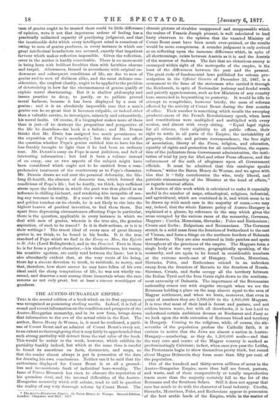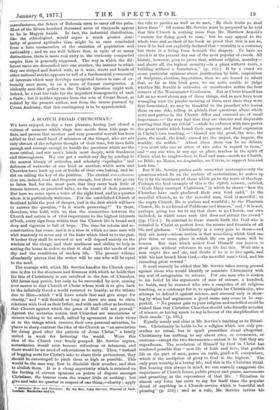THE AUSTRO-HUNGARIAN EMPIRE.*
Tins is the second edition of a book which on its first appearance -was recognised as possessing sterling merits. Indeed, it is full of sound and recent information on the condition and prospects of the Austro-Hungarian monarchy, and in its new form, brings down that information to the eve of the actual crisis in the East. The author, Baron Henry de Worms, is, it must be confessed, a parti- san of Count Beust and an admirer of Count Beust's every act, to an extent so thoroughgoing that it may fairly be apprehended that such strong partiality will detract from the real value of the book. This would be unfair to the work, however, which exhibits its partiality frankly indeed, but which at the same time is careful to found its assertions on facts, documents, and maps, so -that the reader almost always is put in possession of the data for drawing his own conclusions. Neither can it be said that the enthusiasm displayed for Count Beust is at all a ground- less and inconsiderate freak of individual hero-worship. The fame of Prince Bismarck has risen to obscure the reputation of his quondam rival, and the internal difficulties of the Austro- Hungarian monarchy which still subsist, tend to call in question the reality of any very thorough reform by Count Beust. The • The Austro-Hunflarian Empire. By Baron Henry de Worms. Second Mitten. London . Chapman and Hall. 1877. chronic picture of rivalries unappeased and unappeasable which the realms of Francis Joseph present, is well calculated to lead hasty observers to the opinion that the vaunted Ministry of Count Bengt must have been much over-praised, or the results would be more conspicuous. A sounder judgment is only arrived at on reflecting upon the immense difference which, in spite of all shortcomings, exists between Austria as it is and the Austria of the morrow of Sadowa. The fact that no victorious enemy is encamped within sight of the metropolis of the empire, is the least of the differences between the past and the present. The great code of fundamental laws published for solemn pro- mulgation in the Official Gazette of December 22, 1867, is a monument to the fame of the statesman who carried it through the Reichsrath, in spite of Nationalist jealousy and feudal wrath and priestly apprehensions, such as few Ministers of any country have succeeded in bequeathing to posterity. It would be idle to attempt to recapitulate, however briefly, the mass of reforms effected by the activity of Count Beust during the first months of office. Their number is something which recalls the sweeping productiveness of the French Revolutionary epoch, when laws and constitutions were multiplied and multiplied with every session, and almost with every sitting. "Equal legal rights for all citizens, their eligibility to all public offices, their right to settle in all parts of the Empire, the inviolability of property, domicile, and private correspondence, the free right of association, liberty of the Press, religion, and education, equality of rights and protection for all nationalities, the separa- tion of the judicature from Government administration, the insti- tution of trial by jury for libel and other Press offences, and the enforcement of the oath of allegiance upon all Government officials. It must be admitted that this catalogue speaks volumes," writes the Baron Henry de Worms, and we agree with him that it "fully corroborates the wise, truly liberal, and patriotic statesmanship of the Minister at the head of affairs," as regards internal affairs.
A feature of this work which is calculated to make it especially useful is the number of maps, ethnological, religious, industrial, and agricultural, which are contained in it, and which seem to to be drawn up with much care in the majority of cases,—we may say, indeed, that the whole Eastern policy of Austro-Hungary is explained at a glance, by reference to the map which gives the areas occupied by the various races of the monarchy, Germans, Magyars ; Czechs, Moravians, Slovacks ; Poles and Ruthenians ; Croats and Zerbs ; Bulgarians and Roumanians. The Germans stretch in a solid mass from the frontiers of Switzerland to the east of Vienna, and form a fringe on the northern borders of Bohemia and Moravia. They are also scattered in little patches and spots throughout all the provinces of the empire. The Magyars form a single body at the very centre, geographically speaking, of the monarchy, and are again to be found in considerable numbers at the extreme south-east of Hungary. Czechs, Moravians, Slovacks, Poles, and Ruthenians extend in an unbroken sweep from the frontiers of Bavaria to the frontiers of Russia. Slovenes, Croats, and Serbs occupy all the territory between the Italian Tyrol and the Iron Gates right down to the southern- most extremity of Dalmatia. The importance of the Roumanian nationality comes out with singular strength when we see the Roumans holding a place on the map almost equal to the area of Magyar settlement, and when we learn, moreover, that even in point of numbers they are 2,900,000 to the 4,800,000 Magyars. It is true that most of their land is forest and pasture, and not seldom barren waste, but with all drawbacks, it is less hard to understand certain ambitious dreams at Bucharest and Jassy as we look upon the wide extension of Rouman blood and territory in Hungary. Coming to the religions, while, of course, the six- sevenths of the population profess the Catholic faith, it is curious to notice that the Jews are almost a nation in Austro- Hungary—numbering, as they do, 1,200,000 souls—and that the very core and centre of the Magyar country is marked as predominatingly Calvinist; in fact, when once you pass the Leitha, the Protestants begin to show themselves pretty thick, but round about Magyar Debreczin they form more than fifty per cent, of the population.
Oat of the hundred and thirty-seven millions of acres in the Austro-Hungarian Empire, more than half are forest, pasture, and waste, and of these comparatively or totally unproductive tracts more than the majority certainly fall to the lot of the Roumans and the Southern Sclavs. Still it does not appear that race has much to do with the character of local industry. Czechs, Slovacks, Moravians, Poles, and Ruthenians appear in possession of the best arable lands of the Empire, while in the matter of
manufactures, the Sclavs of Bohemia seem to carry off the palm. Most of the fifteen hundred thousand acres of vineyards appear to be in Magyar hands. In fact, the industrial distribution, like the ethnological, would argue a much greater simi- larity of general aptitudes than might be at once concluded from a bare enumeration of the statistics of population and nationality ; and we can well believe that, in spite of so many distinctions, there is more real unity in the curiously compacted empire than is generally supposed. The way in which the dif- ferent races are dovetailed into one another, the manner in which they are striped and dotted with, as it were, rivets and bands of other national stocks, appears to tell of a fundamental community of interests which may develope unexpected forces in case of ex- tremity once more, as on a score of former emergencies. A violently anti-Slav policy on the Turkish Question might well, indeed, be a test too rude for the imperfect homogeneity of such a State ; but it neither appears from the acts of Count Beast, as related by the present author, nor from the course pursued by Count Andrassy, that this contingency is to be apprehended.










































 Previous page
Previous page